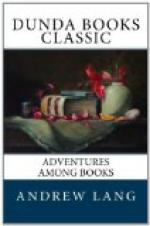In verse, then, Coleridge succeeds with the supernatural, both by way of description in detail, and of suggestion. If you wish to see a failure, try the ghost, the moral but not affable ghost, in Wordsworth’s “Laodamia.” It is blasphemy to ask the question, but is the ghost in “Hamlet” quite a success? Do we not see and hear a little too much of him? Macbeth’s airy and viewless dagger is really much more successful by way of suggestion. The stage makes a ghost visible and familiar, and this is one great danger of the supernatural in art. It is apt to insist on being too conspicuous. Did the ghost of Darius, in “AEschylus,” frighten the Athenians? Probably they smiled at the imperial spectre. There is more discretion in Caesar’s ghost—
“I think it is the weakness
of mine eyes
That shapes this monstrous apparition,”
says Brutus, and he lays no very great stress on the brief visit of the appearance. For want of this discretion, Alexandre Dumas’s ghosts, as in “The Corsican Brothers,” are failures. They make themselves too common and too cheap, like the spectre in Mrs. Oliphant’s novel, “The Wizard’s Son.” This, indeed, is the crux of the whole adventure. If you paint your ghost with too heavy a hand, you raise laughter, not fear. If you touch him too lightly, you raise unsatisfied curiosity, not fear. It may be easy to shudder, but it is difficult to teach shuddering.
In prose, a good example of the over vague is Miriam’s mysterious visitor—the shadow of the catacombs—in “Transformation; or, The Marble Faun.” Hawthorne should have told us more or less; to be sure his contemporaries knew what he meant, knew who Miriam and the Spectre were. The dweller in the catacombs now powerfully excites curiosity, and when that curiosity is unsatisfied, we feel aggrieved, vexed, and suspect that Hawthorne himself was puzzled, and knew no more than his readers. He has not—as in other tales he has—managed to throw the right atmosphere about this being. He is vague in the wrong way, whereas George Sand, in Les Dames Vertes, is vague in the right way. We are left in Les Dames Vertes with that kind of curiosity which persons really engaged in the adventure might have felt, not with the irritation of having a secret kept from us, as in “Transformation.”
In “Wandering Willie’s Tale” (in “Redgauntlet"), the right atmosphere is found, the right note is struck. All is vividly real, and yet, if you close the book, all melts into a dream again. Scott was almost equally successful with a described horror in “The Tapestried Chamber.” The idea is the commonplace of haunted houses, the apparition is described as minutely as a burglar might have been; and yet we do not mock, but shudder as we read. Then, on the other side—the side of anticipation—take the scene outside the closed door of the vanished Dr. Jekyll, in Mr. Stevenson’s well-known apologue:




